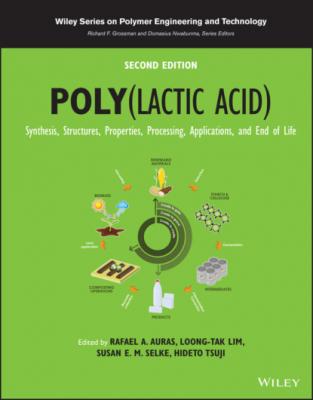Poly(lactic acid). Группа авторов
Читать онлайн.| Название | Poly(lactic acid) |
|---|---|
| Автор произведения | Группа авторов |
| Жанр | Химия |
| Серия | |
| Издательство | Химия |
| Год выпуска | 0 |
| isbn | 9781119767466 |
To recycle these reducing equivalents, microorganisms convert the pyruvate into the more reduced lactic acid; see the reaction in Figure 1.4.
In other words, lactic acid is mainly produced to keep the cellular processes going [30]. The chemical energy obtained is used by several processes elsewhere in the cell, for example cell growth, maintenance, and sometimes even motility.
The reaction in Figure 1.3 takes place in the so‐called homofermentative lactic acid bacteria (LAB). Homofermentative bacteria have almost exclusively lactic acid as a fermentation product, in contrast to heterofermentative bacteria that produce a mixture of lactic acid, acetate, CO2, and acetate or ethanol [31]. Heterofermentative bacteria were believed to use exclusively the so‐called phosphoketolase pathway, and homofermentative bacteria were believed to use exclusively the glycolysis (Figure 1.3) that splits C6 into two C3 molecules [31].
FIGURE 1.2 Lactic acid condensation reactions: interchange between lactide, oligomers, and poly(lactic acid).
FIGURE 1.3 During conversion of glucose to pyruvate, chemical energy (ATP) is generated, as well as reducing equivalents (NADH).
FIGURE 1.4 Lactic acid formation from pyruvate: reoxidation of NADH and NAD takes place; NAD can be used again in the reaction of Figure 1.3.
The phosphoketolase pathway is a route where a C6 is transformed to a C5 sugar (and CO2) and split into a C2 and a C3 molecule. The C3 molecule is then converted to lactic acid, whereas the C2 molecule is converted to acetate or ethanol. In the same traditional view, C5 sugars were regarded as leading to this heterofermentative metabolism, which is less interesting from the point of view of industrial production as a lot of acetic acid or ethanol is produced simultaneously. Although some bacteria seem to fit well in this paradigm, more recent literature has shown that this view is oversimplified and somewhat obsolete for a number of reasons.
Some heterofermentative bacteria are shown to have both pathways active at the same moment and produce mostly lactic acid under certain circumstances [32, 33].
Pentoses can lead exclusively to lactic acid as a fermentation product [34].
Lactic‐acid‐producing organisms that do not have a phosphoketolase pathway can still produce acetate or ethanol, formed by the usual mixed acid fermentation, via pyruvate. This is the case for, for example, Lactococcus lactis [35].
The reason why even heterofermentative bacteria prefer to produce mostly lactic acid is related to the fast generation of chemical energy and thus fast growth and acidification of the environment [32, 36, 37]. The fast growth and acidification gives lactic acid bacteria a competitive advantage and that is exactly why lactic acid bacteria are so troublesome in ethanol fermentations [38]. Lactic acid production is certainly not restricted to bacteria or fungi. Higher organisms, including humans, also use lactic acid formation for fast supply of energy in muscles when needed [39].
The uniformity in this biochemistry is in sharp contrast with the degrees of freedom one has in choosing the microbes, the acid‐neutralizing agent, nutrients, and carbohydrates needed for industrial lactic acid fermentation. Only delicate weighing of the pros and cons of every possibility leads to an economically feasible fermentation.
1.2.4.1 The Microbes
There are several important features a microorganism used for the production of lactic acid must have in order to be industrially attractive:
high productivity to reduce fermentation time,
high conversion yield to reduce carbohydrate costs,
ability to use cheap sources of nutrients to reduce nutrient costs,
high‐end concentration to reduce evaporation costs,
low amount of by‐products to increase purification yield, and, of course,
the organisms must be robust with regard to contamination and infections.
Every microorganism has its own benefits and drawbacks, but lactobacilli (present in many food fermentations) and Rhizopus (a fungus) are the most reported [40]. Besides lactobacilli and Rhizopus, Streptococcus, Pediococcus, Sporolactobacillus inulinus, Bacillus coagulans, and several yeasts are mentioned in the excellent overview by Vaidya et al. [41].
Lactobacilli generally have high productivity, but special and often expensive nutrient requirements. Rhizopus needs much less nutrients, but has a lower yield, needs oxygen, and its morphology is sometimes difficult to handle. Of course, via genetic manipulation, researchers have tried to make an ideal lactic‐acid‐producing microorganism.
1.2.4.2 Stereochemical Purity
To make semicrystalline, high‐melting PLA, stereochemically pure lactic acid is needed. Not all microorganisms yield such stereochemically pure lactic acid and some even produce a racemic mixture [29]. Therefore, a strain must be chosen that meets the quality demands. Finding such a strain that produces L‐lactic acid in an economically feasible manner is relatively easy. Producing D‐lactic acid by bacterial fermentation on an industrial scale is far more difficult.
Several natural D‐lactic‐acid‐producing bacterial species exist; Sporolactobacillus inulinus, Sporolactobacillus laevolacticus (previously Bacillus laevolacticus), and Lactobacillus delbrueckii are among these bacteria [29, 42, 43]. Also, patents have been filed claiming the production of D‐lactic acid by a genetically modified microorganism. Several different species such as Kluyveromyces and Escherichia coli have been claimed so far [44, 45].
1.2.4.3 Nutrients
The most well‐known lactic‐acid‐producing organisms, such as Lactobacillus and Lactococcus species, are members of the taxonomic order of Lactobacillales, also commonly referred to as lactic acid bacteria. These lactic acid bacteria have their really complex nutrient need in common [29]. Vitamins and peptides need to be added to the medium to enable growth. This can be done by adding peptones, yeast extract, or corn steep liquor, but this is expensive. Nutrients for lactic acid production can also be derived from nutrient‐rich waste streams such as rice bran, fish waste, or vinification lees [46–48].
1.2.4.4 Neutralization
Lactic acid fermentation inevitably leads to a drop in pH, and without
